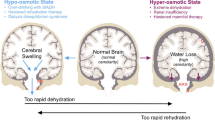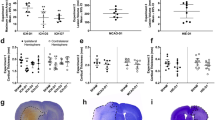Summary
-
1.
The swelling of intact primate cerebral cortex perfused under isosmotic conditionsin vivo, like swelling of slices of mammalian cerebral cortex incubatedin vitro, is a linear function of the concentration of K+ in the extracellular fluid over the range 20–120 mM.
-
2.
The simultaneous presence of the Cl− ion is required for the development of K+-dependent swelling of cerebral cortex under various experimental conditionsin vivo andin vitro.
-
3.
The maintenance of previously established K+-dependent swelling of cerebral cortex bothin vitro andin vivo requires the relative concentrations of both K+ and Cl− in the extracellular fluid to remain constant. A reduction in the concentration of either ion is associated with an absolute loss of fluid of swelling of cerebral cortex.
-
4.
The content of Cl− in cerebral cortex is a function of the magnitude of K+-dependent swelling even though the concentration of Cl− in the extracellular fluid is maintained constant.
-
5.
The mechanism of swelling in primate cerebral cortex following cerebral circulatory arrest is discussed in the light of the experimental findings, as a model of the type of brain injury encountered in massive clinical stroke.
Similar content being viewed by others
References
Ames, A., Isom, J.B., Nesbett, F.B.: Effects of osmotic changes on water and electrolytes in nervous tissue. J. Physiol. (Lond.)177, 246–262 (1965).
Bekaert, J., Demeester, G.: Influence of potassium concentration of the blood on the potassium level of the cerebrospinal fluid. Exp. Med. Surg.12, 480–501 (1954).
Bennett, H.S., Luft, J.H.: s-Collidine as a basis for buffering fixatives. J. biophys. biochem. Cytol.6, 113–114 (1964).
Boretos, J.W., Bourke, R.S., Nelson, K.M., Naumann, R.A.: The isolated subarachnoid space in the intact primate. J. appl. Physiol. (1970) [in press].
Bourke, R.S.: Evidence for mediated transport of chloride in cat cerebral cortexin vitro. Exp. Brain Res.8, 219–231 (1969a).
—: Studies of the development and subsequent reduction of swelling of mammalian cerebral cortex under isosmotic conditionsin vitro. Exp. Brain Res.8, 232–248 (1969b).
—, Gablenick, H.L., Young, O.: Mediated transport of chloride from blood into cerebrospinal fluid. Exp. Brain Res.10, 17–38 (1970).
—, Greenberg, E.S., Tower, D.B.: Variation of cerebral cortex fluid spaces invivo as a function of species brain size. Amer. J. Physiol.208, 682–692 (1965).
—, Tower, D.B.: Fluid compartmentation and electrolytes of cat cerebral cortexin vitro. I. Swelling and solute distribution in mature cerebral cortex. J. Neurochem.13, 1070–1094 (1966a).
— —: Fluid compartmentation and electrolytes of cat cerebral cortexin vitro. II. Sodium, potassium and chloride of mature cerebral cortex. J. Neurochem.13, 1099–1117 (1966b).
Boyle, P.J., Conway, E.J.: Potassium accumulation in muscle and associated changes. J. Physiol. (Lond.)100, 1–63 (1941).
Cotlove, E.: Determination of the true chloride content of biological fluids and tissues. II. Analysis by simple, non-isotopic methods. Anal. Chem.35, 101–105 (1963).
—, Trantham, H.V., Bowman, R.L.: An instrument and method for automatic, rapid, accurate, and sensitive titration of chloride in biologic samples. J. Lab. clin. Med.51, 461–468 (1956).
Cserr, H.: Potassium exchange between cerebrospinal fluid, plasma, and brain. Amer. J. Physiol.209, 1219–1226 (1965).
Elliott, K.A.C.: Brain tissue respiration and glycolysis. In: Neurochemistry, pp. 63–93. Ed. by K.A.C. Elliott, I.H. Page and J.H. Quastel. Springfield/Ill.: Charles C. Thomas 1955.
—, Jasper, H.: Measurement of experimentally induced brain swelling and shrinkage. Amer. J. Physiol.157, 122–129 (1949).
Erlandson, R.A.: A new Maraglas, D.E.R. 732, embedment for electron microscopy. J. Cell. Biol.22, 704 (1964).
Fencl, V., Miller, T.B., Pappenheimer, J.R.: The respiratory response to disturbances of acid-base balance. In: Head Injury, pp. 414–430. Ed by. W. Caveness and A.E. Walker. Philadelphia: J.B. Lippincott Co. 1966.
Frankenhaeusser, B., Hodgkin, A.L.: The after-effects of impulse in the giant fibers ofLoligo. J. Physiol. (Lond.)131, 341–376 (1956).
Goodman, H.O., Wainer, A., King, Jr., J.S., Thomas, J.J.: [35S] 2-hydroxyethanesulfonic acid (isethionic acid) in urine of human subjects given [35S] taurine. Proc. Soc. exp. Biol. (N.Y.)125, 109–113 (1967).
Greengard, P., Straub, R.W.: After potentials in mammalian non-myelinated nerve fibers. J. Physiol. (Lond.)144, 442–462 (1968).
Jacobsen, J.G., Collins, L.L., Smith, Jr., L.H.: Urinary excretion of isethionic acid in man. Nature (Lond.)214, 1247–1248 (1967).
Keynes, R.D., Lewis, P.R.: The sodium and potassium content of cephalopod nerve fibers. J. Physiol. (Lond.)114, 151–182 (1951).
—, Ritchie, J.M.: The movements of labelled ions in mammalian nonmyelinated nerve fibers. J. Physiol. (Lond.)179, 333–367 (1965).
Koechlin, B.A.: On the chemical composition of the axoplasm of squid giant nerve fibers with particular reference to its ion pattern. J. biophys. biochem. Cytol.1, 511–529 (1955).
Nicholls, J.G., Kuffler, S.W.: Extracellular space as a pathway for exchange between blood and neurons in the central nervous system of the leech. Ionic composition of glial cells and neurons. J. Neurophysiol.27, 645–671 (1964).
Ommaya, A.K., Boretos, J.W., Beile, E.E.: The Lexan calvarium: an improved method for direct observation of the brain. J. Neurosurg.30, 25–29 (1969).
Orkand, R.K., Nicholls, J.G., Kuffler, S.W.: Effect of nerve impulses on the membrane potential of glial cells in the central nervous system in amphibia. J. Neurophysiol.29, 788–806 (1966).
Pappius, H.M., Elliott, K.A.C.: Water distribution in incubated slices of brain and other tissues. Canad. J. Biochem.34, 1007–1022 (1956).
Peck, E.J., Awapara, J.: Metabolism of sulfur amino acids in rat brain. Fed. Proc.25, 642 (1966).
Rang, H.P., Richie, J.M.: On the electrogenic sodium pump in mammalian non-myelinated nerve fibres and its activation by various external cations. J. Physiol. (Lond.)196, 183–221 (1968).
Read, W.O., Welty, J.D.: Synthesis of taurine and isethionic acid by dog heart slices. J. biol. Chem.237, 1521–1522 (1962).
Ritchie, J.M., Straub, R.W.: The after-effects of repetitive stimulation on mammalian non- medullated fibers. J. Physiol. (Lond.)134, 698–711 (1956).
Tower, D.B.: The effects of 2-deoxy-D-glucose on metabolism of slices of cerebral cortex incubatedin vitro. J. Neurochem.3, 185–205 (1958).
—: Arrest of sizure activity: biochemical aspects and pharmacology. Epilepsia6, 141–155 (1965).
—: Distribution of cerebral fluids and electrolytesin vivo andin vitro. In: Brain edema, pp. 303–332. Ed. by I. Klatzo and F. Seitelberger. Berlin-Heidelberg-New York: Springer 1967.
—, Bourke, R.S.: Fluid compartmentation and electrolytes of cat cerebral cortexin vitro. III. Ontogenetic and comparative aspects. J. Neurochem.13, 1119–1137 (1966).
Varon, S., McIlwain, H.: Fluid content and compartments in isolated cerebral tissues. J. Neurochem.8, 262–275 (1961).
Wallace, G.B., Brodie, B.B.: The distribution of iodide, thiocyanate, bromide and chloride in the central nervous system and spinal fluid. J. Pharmacol. exp. Ther.65, 220–226 (1939).
Welty, J.D., Reed, W.O., Shaw, E.H.: Isolation of 2-hydroxy-ethane-sulfonic acid (Isethionic acid) from dog heart. J. biol. Chem.237, 1160–1161 (1962).
Author information
Authors and Affiliations
Rights and permissions
About this article
Cite this article
Bourke, R.S., Nelson, K.M., Naumann, R.A. et al. Studies of the production and subsequent reduction of swelling in primate cerebral cortex under isosmotic conditionsin vivo . Exp Brain Res 10, 427–446 (1970). https://doi.org/10.1007/BF02324768
Received:
Issue Date:
DOI: https://doi.org/10.1007/BF02324768




